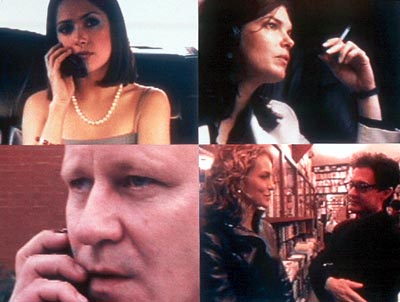

Not all experiments work, and Time Code is a perfect example. Recent films by director/writer Mike Figgis seem to go all over the place. The Loss of Sexual Innocence was a meandering, stream of consciousness semi-autobiographical movie, while Miss Julie was a period piece. Time Code claims to be the first movie shot simultaneously on four digital cameras, all in one take. Essentially, this forces the actors to act without pause for the duration of the movie (some people call this theater). Events also move in real time, which means that approximately an hour and a half pass in the movie. This was done in a similar movie a couple of years ago that no one remembers; Nick of Time starring Johnny Depp.
Although Figgis gets the writing credit, the credits at the end of the movie say that aside from a basic structure, much of the story was improvisation. And it shows. There are four main characters. Saffron Burrows (Miss Julie, Deep Blue Sea) is a wife worried her husband is cheating on her. Stellan Skarsgaard (Ronin, Amistad) is her husband, an executive at Red Mullet productions (also the name of Figgis' actual production company). Skarsgaard is having an affair with Salma Hayek (Wild Wild West, Dogma), an aspiring actress. Jeanne Tripplehorn (Mickey Blue Eyes, Very Bad Things) is Hayek's lover, who suspects something is wrong. Holly Hunter, Kyle MacLachlan, Julian Sands, Alessandro Nivola, and a number of other good actors are also in the film, but they only play marginal roles.
The intriguing thing about Time Code is that four stories play on the screen, which he divided into quarters. Everything happens at the same time, which, in theory sounds distracting, but following the action is relatively easy. Figgis raises the volume on the 'important' quadrant and lowers it on the other three. The stories frequently intersect, with the same character showing on more than one screen. This is probably the main reason to see the film, just to see how Figgis pulls it off. However, the story that emerges is thin and boring. Sands (The Loss of Sexual Innocence, One Night Stand) plays the most amusing role in the film; a masseuse. Red Mullet (in the film) also seems to focus on releasing bad movies, which, unexpectedly carries over into real life. Also, just to remind moviegoers that things are happening at the same time, Figgis frequently interjects earthquakes into the movie. So the camera shakes and everyone looks worried. The effect looks worse than Star Trek, but at least the cameras synchronize well. As a movie, Time Code probably fails, but as a technical exercise, it is far more interesting. The net effect is marginal.